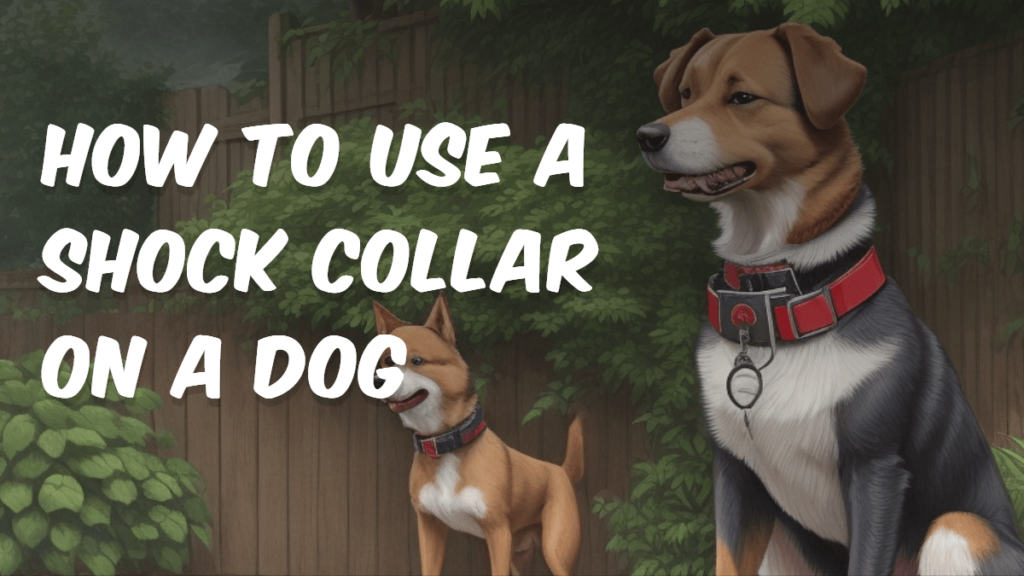1. Understanding Shock Collars
1.1 What is a Shock Collar?
1.2 How Does a Shock Collar Work?
2. How to Use a Shock Collar or Remote Training Collar correctly to Properly Train A Dog
Shock collars, electronic dog training collars, or e-collars can be valuable tools When used to train a dog correctly. However, it’s crucial to understand that they should be employed with care, responsibility, and a focus on your dog’s well-being. Here is a comprehensive guide on how to use a shock collar on a dog:
2.1 Choose the Right Shock Collar
Before you begin using a shock collar, it’s essential to select the appropriate model. Look for a collar with adjustable settings for shock intensity, sound, and vibration. This versatility allows you to tailor the training to your dog’s needs and sensitivity. Ensure the Dog Training Collar fits your dog comfortably and securely.
2.2 Educate Yourself
Take the time to understand how the shock collar properly works. Read the manufacturer’s instructions and user manual carefully. Understanding the functions and settings of the Collar is essential to ensure safe and practical training.
2.3 Set Clear Training Goals
Determine the specific behaviors or commands you want to address through electric collar training. Common training goals include leash manners, recall, and discouraging excessive barking. Setting clear objectives will guide your training sessions and help you measure progress.
2.4 Introduce the Collar Gradually
Before using the shock feature, let your dog become accustomed to wearing the Collar. Begin by having your dog wear the Collar without any stimulation. This helps them associate the Collar with a neutral experience.
2.5 Start with the Lowest Settings
When you’re ready to train with the shock function, always begin with the lowest intensity setting. The sensation should be mildly uncomfortable but never painful. Observe your dog’s reaction and adjust the intensity as needed, ensuring it is appropriate for your dog’s size and temperament.
2.6 Pair Stimulation with Commands
To effectively communicate with your dog, pair the shock stimulation with a specific verbal command or cue. For example, if you use the Collar to address excessive barking, say “quiet” before applying the stimulation. Over time, your dog will associate the command with the Collar’s feedback.
2.7 Use Positive Reinforcement
Incorporate positive reinforcement into your training sessions. Reward your dog with treats, praise, or affection when they respond correctly to your commands. Positive reinforcement helps reinforce desired behaviors and fosters a positive training experience.
2.8 Keep Training Sessions Short
Shock collar training sessions should be brief and focused, typically lasting no more than 15-20 minutes. Frequent short sessions are more effective than long, extended ones. Maintain a patient and constant attitude.
2.9 Monitor Your Dog’s Reaction
Always pay close attention to your dog’s reactions during training. If you notice signs of distress, anxiety, or fear, discontinue the training session immediately. The idea is to provide your dog a fulfilling learning experience.
2.10 Seek Professional Guidance
3. The Importance of Dog Training to Train a Dog with a Shock Collar

3.1 Precision Training
3.2 Off-Leash Control
Shock collars can be super helpful for dog owners who want their dogs to listen without a leash, like when hiking or during outdoor adventures. They let you keep control of your dog’s actions even when there’s no leash to hold them back.
3.3 Addressing Behavioral Problems
3.4 Customized Training
Shock collars usually let trainers change the strength of the shock. Depending on the dog’s size, personality, and sensitivity, they can make it softer or firmer. This way, the training is kind and ensures the dog doesn’t feel too uncomfortable or stressed.
3.5 Enhanced Safety
Shock collars can provide safety protection, such as teaching your dog to avoid potentially dangerous objects or problems. They enable trainers to redirect their dog’s attention away from hazards quickly.
3.6 Effective Communication
Shock collars can help owners talk to their dogs better when they use clear words or commands. With practice, dogs connect the command with the feeling from the collar, which helps them understand what the owner wants them to do.
3.7 Versatility
4. Safety Measures For Shock Collar Training
When using a shock collar for dog training, ensuring the safety and well-being of your furry friend should always be a top priority. Here are some crucial safety precautions to remember:
4.1 Limited Usage:
Never leave the shock collar on your dog for extended periods. It’s a training tool, not a permanent accessory. Only use it during training sessions and remove it when your dog is not in training.
4.2 Regular Checks:
4.3 Proper Fit:
Ensure that the shock collar fits your dog correctly. It should be snug but not too tight. A too-tight collar can cause discomfort, while one too-loose may not function correctly.
4.4 Read the Manual:
Learn the instructions and rules from the collar maker for the shock collar you have. Each collar might have exceptional advice to use it safely.
4.5 Use Low Intensity:
Start training on Collarllar with the lowest intensity setting. Only increase the intensity if necessary and if you’re sure it’s not causing distress to your dog. Always prioritize their comfort.
4.6 Supervision:
Never leave your dog unattended while wearing the shock collar. You should be present during training sessions to monitor their reactions and ensure their safety.
4.7 Alternate Training Methods:
Include the shock collar as part of your training plan, along with rewards, words, and treats. Don’t use only the collar for training.
4.8 Professional Guidance:
If you have concerns or doubts about using the shock collar, consult a professional dog trainer or a veterinarian. They can provide expert guidance and ensure you use Collar safely and effectively.
4.9 Avoid Fear or Harm:
Never use the shock collar to instill fear or harm in your dog. The goal is to correct behavior and encourage positive responses, not to cause pain or distress.
4.10 Remove During Play and Rest:
Permanently remove the shock collar when your dog plays or rests. This allows them to relax without any discomfort.
When you do these safety steps, you ensure your dog’s training with a shock collar is safe and works well. Using the collar responsibly is essential to keep a good and loving bond with your dog.
5. Ensuring Ethical Use of Dog Shock Collars To Train Your Dog

The ethical use of shock collars should always be a top priority for any responsible dog owner or trainer. The following essential actions must be taken to guarantee that dog shock collar training is carried out humanely and ethically:
5.1 Seek Professional Guidance
5.2 Use the Lowest Effective Level
When you use a shock collar, always start with the lowest intensity setting. The goal is to find the minimum stimulation level required to achieve the desired behavior modification. Using excessive force can cause unnecessary stress and discomfort for your dog.
5.3 Positive Reinforcement
Shock collar training should never rely solely on punishment. Utilize the collar in conjunction with approaches for positive reinforcement. Whenever your dog responds correctly to a command, immediately reward them with treats, praise, and affection. This balanced approach helps your dog associate good behavior with positive outcomes.
5.4 Regularly Check Fit and Skin Condition
Make sure your dog is comfortable and safe. Put the collar on the right way by following the instructions. Also, check your dog’s neck often for problems like redness or discomfort from the collar. If you see any issues, stop using the collar right away.
5.5 Limited Duration
6. Common Misconceptions About Shock Remote Collars
6.1 They Are Always Harmful
Many people think shock collars always hurt dogs, but that’s not true. When used the right way, they can train dogs without damaging them. The main aim is to communicate and teach, not hurt your dog.
6.2 They Are a Lazy Training Tool
7. When to Consult a Professional
7.1 Aggression Issues:
7.2 Fear or Anxiety:
If your dog is scared or anxious, shock collar training might not suit them. A pro can figure out why they feel this way and suggest better ways to help them behave.
7.3 Unresponsiveness to Training:
Talk to a trainer if your dog isn’t learning well, even with the collar and rewards. They can find out what’s causing the problem and make a unique training plan.
7.4 Complex Behavioral Problems:
7.5 Specialized Training Needs:
7.6 First-Time Dog Owners:
If you’re a first-time dog owner or new to using a shock collar to train a dog, consulting a professional trainer can help ensure you use Collar correctly and effectively.
7.7 Concerns about Collar Usage:
Suppose you have concerns about using a shock collar, its effects on your dog, or its appropriateness for your training goals. Consulting a professional can provide clarity and alternative training methods in that case.
A pro trainer knows a lot about dogs and can help with your dog’s unique needs. They make training easier and better for your pet. Keep your dog safe and comfy when you ask a pro for help with behavior and training.
Conclusion
FAQs
Can shock collars harm my dog?
Shock collars are generally safe when used responsibly and at appropriate levels. However, if you have any worries, speak with a veterinarian or qualified trainer.
Are shock collars cruel?
It depends on their usage. Shock collars should not be used to cause harm or fear. They should be part of a broader training strategy focused on positive reinforcement.
Can shock collars work for aggressive dogs?
You can use shock collars for aggression, but only with a trainer who knows about aggressive behavior.
How long should I use a shock collar for training?
The duration of shock collar use varies based on your dog's responsiveness. Once your dog consistently obeys commands, you can gradually reduce usage.
Are there alternative training methods for shock collars?
Yes, Positive reinforcement, clicker training, and professional dog training are effective alternatives.
Can I use a shock collar on a puppy?
Puppies have more sensitive necks, so extreme caution is necessary. Consult a vet or trainer before using a shock collar on a puppy.

